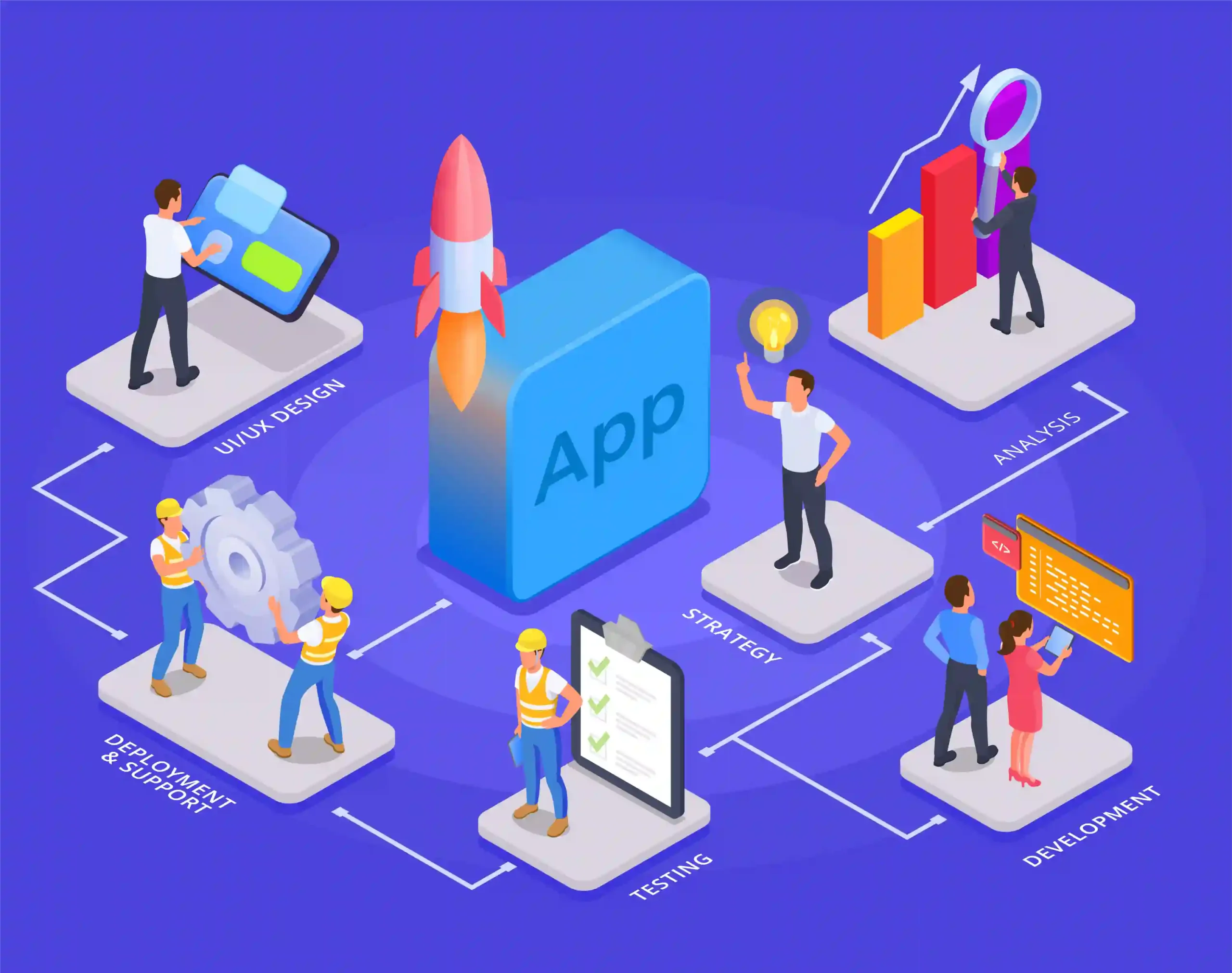Key Takeaways:
- Tailor-made solutions crafted from scratch, aligning precisely with specific business goals and processes.
- Streamlining processes and fostering innovation through integration of cutting-edge technologies, ensuring a competitive advantage.
- From conceptualization and planning to deployment and ongoing maintenance, a structured approach ensures a successful web application development lifecycle.
- Incorporate user authentication, payment gateways, notifications, advanced search options, and analytics for a robust and functional custom web application.
In the rapidly evolving landscape of the digital era, the reliance on web applications has become paramount for businesses aiming to optimize processes, elevate user experiences, and secure a competitive advantage. Regardless of whether you are a startup, a small business, or a large enterprise, the pivotal role of a custom web application in addressing your specific needs cannot be overstated. This comprehensive guide aims to provide an in-depth exploration of the realm of custom web application development, spanning from fundamental concepts to advanced features and industry best practices. At the core of this guide lies an understanding of the foundational principles of custom web application development. As businesses embark on this journey, it is imperative to grasp the significance of tailoring solutions to their unique requirements. Unlike off-the-shelf applications, custom web applications are crafted with precision, aligning seamlessly with the specific workflows and objectives of a given enterprise. This bespoke approach not only enhances efficiency but also empowers organizations to differentiate themselves in the market by offering distinctive functionalities that cater to their niche.
What is a Custom Web Application?

A custom web application is a specialized or tailor-made software solution developed to address the unique business needs, processes, and challenges of a specific organization. Unlike off-the-shelf software, custom web apps are built from scratch, ensuring they align perfectly with your business goals. Here’s why custom web applications matter:
Personalization:
In the realm of custom web application development, personalization stands as a cornerstone feature that sets these applications apart. Unlike off-the-shelf solutions that offer generic functionalities, custom apps are tailored to the unique needs and preferences of a business. This level of customization ensures that users have a highly personalized experience, interacting with features and interfaces that align precisely with their requirements. Whether it’s the user interface, specific functionalities, or data presentation, personalization enhances user satisfaction, engagement, and ultimately contributes to the success of the application.
Efficiency:
One of the primary objectives of custom web applications is to streamline processes and enhance operational efficiency. By identifying and automating repetitive tasks and workflows, these applications significantly reduce the manual workload on employees, allowing them to focus on more strategic and value-added activities. Automation not only minimizes the risk of errors but also accelerates the pace at which tasks are completed. The efficiency gains achieved through custom web apps translate into improved productivity, reduced operational costs, and an overall more agile and responsive business environment.
Innovation:
Custom web applications empower businesses to innovate and stay at the forefront of technological advancements within their industry. The flexibility inherent in custom development allows for the integration of cutting-edge technologies such as artificial intelligence, machine learning, and IoT. By harnessing these innovations, businesses can enhance their processes, offer novel features, and deliver a competitive advantage. Custom web apps, designed with innovation in mind, enable organizations to adapt to changing market dynamics, anticipate future trends, and continuously evolve to meet the evolving needs of users and the industry.
Competitive Advantage:
A well-designed custom web application is not merely a tool but a strategic asset that can provide a significant competitive advantage. Custom apps, tailored to the specific requirements and objectives of a business, enable organizations to differentiate themselves in the market. Whether it’s by offering unique features, delivering a superior user experience, or being more responsive to customer needs, a custom app positions a business ahead of competitors. This competitive edge is not only derived from the application’s functionality but also from its ability to adapt and evolve seamlessly with the changing landscape, ensuring sustained success in a dynamic business environment.
7-Step Custom Web App Development Process

Creating a custom web application involves several stages. Let’s break down the process step by step:
1. Conceptualization and Planning
This phase serves as the blueprint for the entire project. Define your objectives, target audience, and key features. Consider scalability, security, and user experience.
2. Requirements Gathering
Collaborate with stakeholders to gather detailed requirements. Understand user needs, functionality, and technical specifications.
3. Design and Prototyping
Create wireframes, mockups, and prototypes. Design the user interface (UI) and user experience (UX) elements.
4. Development
Develop the application using appropriate technologies (more on this later). Follow agile methodologies for flexibility.
5. Testing and Quality Assurance
Thoroughly test the app for functionality, security, performance, and compatibility. Fix any issues identified.
6. Deployment and Launch
Deploy the app on servers, configure databases, and ensure smooth launch. Monitor performance post-launch.
7. Maintenance and Updates
Regularly maintain and update the app to address bugs, security vulnerabilities, and feature enhancements.
How to Build a Web Application
Building a web application involves choosing the right technology stack, which includes:
Conceptualization and Planning
The conceptualization and planning phase lay the foundation for a successful custom web application development project. During this crucial stage, it is imperative to define the project’s objectives, identify the target audience, and outline key features. Additionally, considerations for scalability, security, and user experience are vital components of the project blueprint. By carefully mapping out these aspects, businesses ensure that the subsequent stages of development align with their overarching goals.
Requirements Gathering
Collaboration with stakeholders is paramount in the requirements gathering phase. By engaging with end-users, clients, and other relevant parties, detailed requirements are collected. This involves understanding user needs, defining functionalities, and specifying technical specifications. Clear communication and collaboration in this phase set the stage for a development process that accurately addresses the expectations and requirements of all stakeholders.
Design and Prototyping

In the design and prototyping phase, the project takes visual shape. Wireframes, mockups, and prototypes are created to provide a tangible representation of the user interface (UI) and user experience (UX) elements. This phase not only ensures that the aesthetic and functional aspects meet expectations but also allows for feedback and adjustments before moving forward. A well-crafted design sets the tone for a user-friendly and visually appealing application.
Development
Armed with a comprehensive plan and detailed requirements, the development phase commences. Developers use appropriate technologies, adhering to the specifications outlined in earlier phases. Adopting agile methodologies ensures flexibility and adaptability during the development process. Regular collaboration between developers, designers, and stakeholders is essential to address any challenges promptly and keep the project on track.
Testing and Quality Assurance
Testing and quality assurance are integral components to ensure the reliability and performance of the developed application. Thorough testing covers functionality, security, performance, and compatibility with various devices and browsers. Any identified issues are addressed promptly to deliver a polished and reliable final product. Rigorous testing not only ensures a bug-free application but also enhances user satisfaction and trust.
Deployment and Launch
The deployment and launch phase involves putting the developed application onto servers, configuring databases, and ensuring a smooth launch. Careful planning and execution during this stage are crucial to avoid disruptions and ensure a seamless transition from development to production. Post-launch, continuous monitoring of performance helps identify and address any unforeseen issues promptly.
Maintenance and Updates
The final phase involves the ongoing maintenance and updates of the application. Regular maintenance is essential to address bugs, security vulnerabilities, and to implement feature enhancements. This iterative process ensures that the custom web application remains current, secure, and aligned with evolving user needs and industry trends. Regular updates contribute to the longevity and success of the application in a dynamic digital landscape.
Simple and Advanced Features for Custom Web Apps
When developing a custom web application, it’s crucial to consider a blend of both simple and advanced features to meet user needs and provide a competitive edge. Here are some features to consider integrating into your custom web application:
User Authentication and Authorization: Secure user access with login, registration, and role-based permissions
- Simple Feature: Implement a straightforward user authentication system allowing users to create accounts, log in securely, and reset passwords if needed.
- Advanced Feature: Incorporate role-based permissions to ensure that different user roles have access to specific features and functionalities. This enhances security and tailors the user experience based on roles, such as admin, regular user, or moderator.
Payment Gateways: Enable seamless transactions

- Simple Feature: Integrate basic payment processing capabilities, allowing users to make transactions securely using standard payment methods.
- Advanced Feature: Integrate multiple payment gateways for increased flexibility, accommodating various user preferences. Implement subscription models, one-click payments, and seamless checkout processes to enhance the overall user experience.
Notifications and Alerts: Keep users informed
- Simple Feature: Implement basic notification alerts for common actions, such as new messages, updates, or system alerts.
- Advanced Feature: Incorporate real-time push notifications, allowing users to receive updates instantly, enhancing user engagement. Personalize notifications based on user preferences and behavior to make them more relevant.
Search and Filters: Enhance data retrieval
- Simple Feature: Integrate a basic search functionality that allows users to search for content within the application.
- Advanced Feature: Implement advanced search algorithms, filters, and sorting options to facilitate efficient data retrieval. Consider incorporating predictive search suggestions and dynamically updating filters based on user interactions for an enhanced user experience.
Analytics and Reporting: Track user behavior and app performance.
- Simple Feature: Implement basic analytics to track user activity, page views, and basic performance metrics.
- Advanced Feature: Integrate comprehensive analytics tools for in-depth insights into user behavior, allowing businesses to make data-driven decisions. Provide customizable reports, heatmaps, and user journey tracking to understand how users interact with the application.
Custom Web Application Development Services
When seeking custom web application development services, it’s crucial to partner with a company that not only possesses technical expertise but also understands the intricacies of your industry. The success of your project often hinges on the ability of the development team to deliver end-to-end solutions while prioritizing user-centric design. Here’s an elaborate breakdown of the key aspects to consider:
Industry Understanding:
- Customization for Specific Industries: Look for a development team with experience in developing web applications tailored to your specific industry. Whether it’s healthcare, finance, e-commerce, or any other sector, industry-specific knowledge is invaluable.
- Domain Expertise: A development team familiar with the challenges and requirements of your industry can provide insights that contribute to the success of your project. This expertise ensures that the final product aligns seamlessly with your business goals.
End-to-End Solutions:
- Comprehensive Services: Opt for a development partner that offers end-to-end solutions encompassing every phase of the development lifecycle. This includes conceptualization, requirements gathering, design, development, testing, deployment, and ongoing maintenance.
- Scalability: Ensure that the development team has the capacity to scale with your business. A comprehensive service provider can adapt to evolving project requirements, ensuring that your web application remains robust and efficient as your business grows.
User-Centric Design:
- User Experience (UX) Focus: Prioritize a development team that places a strong emphasis on user-centric design. This involves creating intuitive interfaces, optimizing user journeys, and ensuring that the application is both aesthetically pleasing and easy to navigate.
- User Testing: A commitment to user-centric design includes rigorous testing with actual users. Look for a development team that conducts usability testing, gathers feedback, and iteratively improves the user experience based on real-world usage.
Technology Stack:
- Adaptability: Choose a development team that is proficient with a diverse range of technologies. This adaptability ensures that your web application is built using the most suitable and up-to-date technologies for your project requirements.
- Security Measures: Security is paramount in web applications. Ensure that the development team follows best practices for secure coding, data encryption, and protection against common vulnerabilities to safeguard your application and user data.
Client References and Portfolio:
- Past Projects: Evaluate the development team’s portfolio to assess their capabilities and the diversity of projects they have undertaken. Look for case studies or testimonials that demonstrate successful outcomes.
- Client References: Reach out to past clients if possible, to gather insights into their experience working with the development team. Feedback from previous clients can provide valuable perspectives on the team’s professionalism, communication, and ability to deliver on promises.
Communication and Collaboration:
- Transparent Communication: A reliable development team maintains transparent communication throughout the project. Regular updates, clear documentation, and open channels for discussions contribute to a collaborative and productive working relationship.
- Project Management: Confirm that the development team utilizes effective project management methodologies such as Agile or Scrum. This ensures that the development process is iterative, adaptable, and aligned with your evolving needs.
Custom web application development companies:
Custom web application development companies specialize in creating bespoke software solutions tailored to meet the specific needs of businesses or individuals. These companies bring together a team of skilled developers, designers, and project managers to work closely with clients, translating their unique requirements and ideas into functional, scalable, and secure web applications. Unlike off-the-shelf software, custom web applications are developed to address particular challenges, integrate seamlessly with existing systems, and improve operational efficiency. These companies employ a variety of technologies, frameworks, and methodologies, such as Agile and DevOps, to ensure that the final product is not only innovative but also delivered on time and within budget. By leveraging the latest in web technologies, these firms help businesses gain a competitive edge, enhance user experience, and drive digital transformation.
How Crongenix helps doing Custom Web Application Development
At Crongenix, we understand the pivotal role that personalized web applications play in optimizing processes, enhancing user experiences, and securing a competitive advantage. Our comprehensive approach ensures a deep understanding of your industry, providing tailored solutions for sectors like healthcare, finance, e-commerce, and more. Throughout the development lifecycle, Crongenix offers end-to-end services, from conceptualization and planning to deployment, maintenance, and updates. Our team’s expertise lies in delivering user-centric design, focusing on intuitive interfaces, optimized user journeys, and thorough testing to guarantee a seamless user experience. Crongenix excels in adapting to diverse technology stacks, integrating cutting-edge features, and implementing robust security measures to safeguard your application and user data. With transparent communication, effective project management methodologies, and a proven track record of successful projects, we are your reliable partner in custom web application development. Whether you are a startup seeking innovation, a small business aiming to streamline processes, or a large enterprise looking for a strategic asset, Crongenix is here to collaborate and transform your vision into a reality. Let us help you position your business at the forefront of digital innovation and growth.
Frequently Asked Questions (FAQs)
1) What is the significance of custom web applications over off-the-shelf solutions?
Custom web applications are tailored to the unique needs and workflows of a specific organization, offering personalized features and functionalities. This level of customization enhances efficiency, user satisfaction, and provides a competitive advantage in the market.
2) What are the key steps in the custom web application development process?
The custom web application development process involves conceptualization and planning, requirements gathering, design and prototyping, development, testing and quality assurance, deployment and launch, and ongoing maintenance and updates.
3) What features should be considered for integration into a custom web application to enhance user experience?
Features such as user authentication and authorization, payment gateways, notifications and alerts, search and filters, and analytics and reporting can be integrated to provide both simple and advanced functionalities, improving overall user satisfaction.
4) How do custom web application development companies ensure success in projects?
Successful custom web application development companies focus on industry understanding, providing end-to-end solutions, prioritizing user-centric design, adapting to various technology stacks, implementing robust security measures, and maintaining transparent communication throughout the project.
5) How does Crongenix contribute to custom web application development, and what makes it stand out?
Crongenix excels in delivering end-to-end services with a focus on user-centric design, adapting to diverse technology stacks, and implementing robust security measures. With transparent communication and a proven track record, Crongenix serves as a reliable partner in transforming your vision into a successful custom web application.
